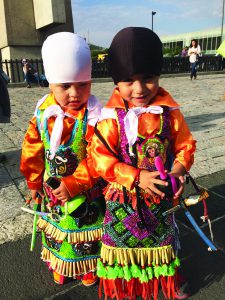Imagining what life was like nearly 1,000 years ago, is only possible when you close your eyes and tune everything out. I decided to do just that, as I stood before the Mayan ruins of Chichen Itza. The intense heat didn’t make it easy. Cameras clicking left and right was also distracting. But it’s not every day one gets to experience one of the seven wonders of the modern world. If this site was once considered the hub of the magical, the religious, and everything in between, I had to at least give it a try.
I imagined what Mayans talked about as they roamed around this Mayan center on Mexico’s Peninsula of Yucatan. Did they walk around with weapons? What, if anything, would they wear on a daily basis? How could they trek such long distances in this extreme heat?
Like with all ancient civilizations, it is always a challenge to try and piece together an entire people from incomplete ruins. Luckily, some of Chichen Itza’s treasures are not buried, but rather engrained in plain sight in the architecture itself.
When I snapped out of my attempt to go back in time, I heard synchronized clapping from a group of tourists standing in front of the main pyramid – The Temple of Kukulkan, also “El Castillo,” or “The Castle.” It seemed harmless enough. When they moved out of the way, I stepped in, front and center and started clapping. I was immediately impressed. Apparently even back then, there were sound engineers whose main responsibility was to connect sound with the divine, to find a way to link mortals with the intangible. The sound of one’s clap travels all the way to the top of the temple. Seconds later, one hears the echo of one’s clap as if it were a chirping bird crying out. Even more impressive is this: only people standing smack in the center can hear it; those standing along the sides are not as fortunate. This was no coincidence. Experts say it was designed that way, so that religious authorities and the elite, who were often placed before the temple, could boast that they could indeed hear the response from the divine and the unknown. Those who were gathered around though, were not as fortunate because of their social status.
Just as impressive was the Maya’s knowledge of Astronomy. The temple has 365 steps, representing each day of the year. Each one of the four sides has 91 steps. The main platform at the top represents a day as well. Twice a year, as the spring and autumn equinoxes set, a shadow falls on a side of the pyramid. The shadow has the shape of a serpent which appears to move along as the sun sets. The Maya’s astronomical skills were so advanced they could even predict solar eclipses.
While Hollywood will always be Hollywood with its special effects and epic battles, Mel Gibson’s 2006 “Apocalypto” film does show some visual similarities to the real thing. As I walked along with the hypnotizing heat, I kept on telling myself: “I would never survive a war here. I would be the first one out.”
Then of course, there are the human sacrifices that were regularly offered to Mayan gods. What greater gift, they believed, could one offer but life itself? While I cringed in disgust at the gruesome nature of the sacrifices, it did bring up the question of how a civilization sees life, death, culture, and most importantly, the value it places on each one of these.
So what does this all mean now and how does it connect to the present? Immediately, the Day of the Dead comes to mind. The notion of death not having the last word, or even the last laugh. The notion of seeing death as a different phase in life, but not necessarily darkness and nothingness. The Mayans believed death was not the end, but a meeting with the afterlife. It seems like the essence of this tradition has been passed on to today’s Mexico.
Chichen Itza, which literally means ‘at the mouth of the well of the Itza people’ attracts approximately 1.5 million tourists each year. Some actually sign up to swim in underground sinkholes in the vicinity, which sounds a lot scarier than it really is. Of course, most visitors don’t start off in the ancient ruins of Chichen Itza. Most start off in the crystal clear waters of Cancun, about two to three hours away, where a seemingly endless strip of hotels are scattered along the main road.
Along the popular beaches of Cancun, visitors can’t walk a few blocks without seeing improvised kiosks with water tours, scuba diving and travel packages to nearby towns. While these can be well worth one’s time and money, they are usually in the outskirts of Cancun and not in the city itself. With the U.S. dollar gaining more and more value against the Mexican peso, it’s only a matter of time before even more Americans flock into this Mexican paradise.
Cancun is mostly a place where one goes to sit before the ocean for hours on end, while enjoying a tropical drink under some shade. While the college crowd sets out to the city’s nightlife, the non-college crowd usually goes there to disconnect, relax and enjoy. 
If done right, one can combine the relaxing nature of the ocean, the adventure of extreme sports, and the history of an ancient civilization. If that’s not a real vacation, I don’t know what is.
